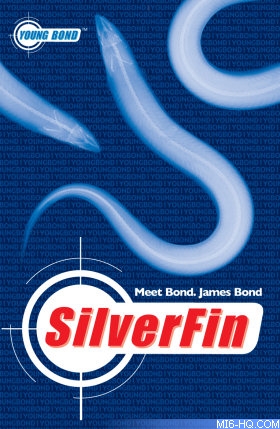 |
| |
MI6 reviews SilverFin - the first book in the Young
James Bond series by Charlie Higson...
|
|
Young Bond: SilverFin - Review
1st March 2005
"SilverFin" by Charlie Higson; 372 pages; £5.99;
Puffin 03 March 2005
Book review by Lynne Yeagers
Charlie Higson can be quoted as saying – tongue in cheek
- of his new series of books about the young Bond … “I
can’t help but suspect they’re going to be the greatest
books ever written, Fleming aside.” (The Times Magazine
Sat. 26 February 2005).
The genre of novels for the 9-13 age range has expanded since
the advent of J K Rowling’s stories of Harry Potter, but
don’t expect the jokes, gags and putdowns on every page
as in Harry Potter and the Order of the Phoenix as you read SilverFin.
There is no witchcraft and no wizardry. However, humour and high
drama are evident. Chapter 17 opens with a clever repartee and
if it is true that the measure of a good book is that it makes
you laugh out loud in public, then Higson has truly succeeded.
The book comes like a breath of fresh air
for the target audience and introduces them to an era of
which many may not have prior knowledge, that of 1930s Eton.
It is reminiscent in places of the Antony Buckeridge Jennings
and Derbyshire stories that children of the 1950s grew up
with. Perhaps Higson himself was an avid reader of them,
or listened intently to serialisations on the long lamented
Children’s’ Hour; the book would serialise well
on Radio 4’s Go For It.
Sean Wright’s novels about Jesse Jameson are more
akin to those of Rowling, but a common factor emerges with
the feature that the main character is a teenaged orphan,
the young James Bond. He is discontented with the prospect
of boredom during the Easter break from Boarding school
(Eton does not quite equate with Hogwarts, more with the
schooldays of the fore mentioned Jennings and Derbyshire).
Right: Cover art for the British first
edition paperback (Puffin)
|
|

 Buy
Now - Amazon UK
Buy
Now - Amazon UK
 Buy
Now - Amazon USA
Buy
Now - Amazon USA |
Social and moral issues, including the death of a parent, are
raised in the book. The older and very street-wise Red Kelly and
James have diametrically opposed social backgrounds but the reader
may be led to question whether or not they are both orphans and
thus share a common ground. Higson alerts the reader to bullying,
cheating, friendship and the divide between the rich and poor
end of Chapter 21. The coiled serpent of sexuality is not unleashed
in James in this novel - having been kissed on the mouth by Wilder
Lawless his reaction was to wipe his mouth. However, he is aware
of the physical attributes of Wilder and Martini (her horse).
There is an opportunity for structured discussion and debate following
these sections of the book and could find itself a useful tool
for Literacy and /or PSHE&C teachers. Such topics run parallel
to the works of Jacqueline Wilson who also writes successfully
for the Key Stage 2 and 3 audiences (“Key Stages”
are part of the British education system).
High drama scenarios create a sense of anxiety in the reader,
as Higson’s use of language is so explicit; there is no
question of how the young James felt in Chapter 17 when he and
Red Kelly briefly found a place of safety. Themes and ideas are
cleverly linked throughout the book; Uncle Max had survived by
eating raw turnips at one stage of his life and when James opens
a sack and finds the contents to be turnips, Higson neatly reminds
us of the event by stating that James’ reaction was that:
“He smiled and shook his head”.
We are treated to historical facts with the mention of Hitler
and war and there is a strong parallel between the ‘super
race’ theme and that of Mary W Shelley in her novel of Frankenstein,
or the Modern Prometheus, of 1818. Similarly we gain an insight
into the social functioning of the Laird of the Manor and the
‘blooding’ of the young George Hellebore. The bullying
and ‘fagging’ at public school provide both a social
and an historical perspective to the novel.
Greek mythology is referred to with the use of simile re the
eels being ‘like the writhing hair of some underwater Medusa.’
We also have reference to Beatrix Potter and Peter Rabbit, the
literature of the era of the young James Bond and his creator
Ian Fleming.

Above: Charlie Higson |
|
The chapter entitled ‘The Gadarene Swine’
questions our biblical knowledge whilst the mysteries of
the workings of the 4-stroke engine are explicitly explained
so that even the non-mechanically minded of the readers
can understand its intricacies. Higson spends time on this
as the car is an Aston Martin and is an important link through
the young Bond’s life into adulthood. In the same
vein, we are presented with a hint of his handsome, good
looks and the importance of featuring striking women in
his adult life.
If we read SilverFin with prior knowledge of Ian Fleming’s
writing or films of his novels we can see the influence
of James’ formative years, not forgetting the importance
of Uncle Max in the young James’ life, on the adult
James as 007.
|
SilverFin is written in the style of an Ian Fleming novel and
like the Harry Potter stories is presented in three parts, but
unlike the writing of Rowling, has an introductory passage that
is integral to the novel. It will appeal both via style and content
to the target group and their mature relatives alike.
Readers are likely to eagerly await the second Young Bond Adventure
due out in January 2006.
Reviewer Lynne Yeagers has been teaching English for over
thirty years to 9-18 year-olds in Lincolnshire, UK. This review
was based on the British edition published by Puffin.